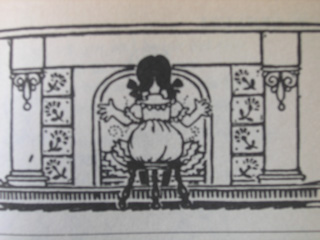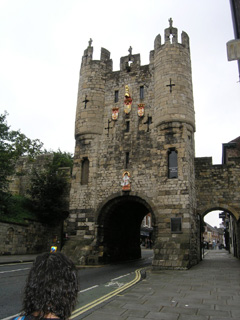Last of York.
 Christmas Quilt is finished.
Christmas Quilt is finished. Border pieces buttoned into place backed in felt.
Border pieces buttoned into place backed in felt. Baubles on the tree.
Baubles on the tree.

 Week 8’s Blocks finished in pleanty of time for the last lesson this week.
Week 8’s Blocks finished in pleanty of time for the last lesson this week.
 Little Polly Flinders by C. Folkard. I am home with not such nice weather- we’ve been having rain and overcast skies, but hopefully today the 1st of September will be better. I’ve a nice feeling about this month. Is it time to knit do you think?
Little Polly Flinders by C. Folkard. I am home with not such nice weather- we’ve been having rain and overcast skies, but hopefully today the 1st of September will be better. I’ve a nice feeling about this month. Is it time to knit do you think?
 Map of York Centre, click to enlarge.
Map of York Centre, click to enlarge. City walls on Nunnery Lane west of the River Ouse.
City walls on Nunnery Lane west of the River Ouse.
 I’ve noticed a lot of Rowan berries this year. I think that’s meant to mean a hard Winter.
I’ve noticed a lot of Rowan berries this year. I think that’s meant to mean a hard Winter. There’s a bit of a clock theme to this post. This one was high on a chimney stack.
There’s a bit of a clock theme to this post. This one was high on a chimney stack. This is the Micklegate.
This is the Micklegate.
 With zoom
With zoom With my camera.
With my camera. Plaque with it’s history. Click to read.
Plaque with it’s history. Click to read. Stocks in a churchyard in Bridge Street.
Stocks in a churchyard in Bridge Street. Down the hill to the bridge -Regency buildings.
Down the hill to the bridge -Regency buildings. Another touch of Dickens.
Another touch of Dickens. I loved these Canadian Geese- the water ripples were wonderful.
I loved these Canadian Geese- the water ripples were wonderful.

 View from the bridge.
View from the bridge. Zoomed
Zoomed The river had flooded recently.
The river had flooded recently. People were still cleaning up.
People were still cleaning up. The bridge and reflection was like a row of eyes.
The bridge and reflection was like a row of eyes. East side of the river.
East side of the river. More beautiful buildings.
More beautiful buildings.

 The market still on the same site for 100s of years.
The market still on the same site for 100s of years. In places I think you could shake hands with the person in the room opposite in the Shambles.
In places I think you could shake hands with the person in the room opposite in the Shambles.

 This almost shows the history of the architecture of the town in one shot! LOL
This almost shows the history of the architecture of the town in one shot! LOL This made me laugh.
This made me laugh. Someone had put a pile of artificially made snow for the children to play on. Perhaps this idea was made thinking to cool children down in the Summer.
Someone had put a pile of artificially made snow for the children to play on. Perhaps this idea was made thinking to cool children down in the Summer. More beautiful buildings. There was a very good guitar busker in this area soI lingered.
More beautiful buildings. There was a very good guitar busker in this area soI lingered.

 Another clock with a figure on the side.
Another clock with a figure on the side.
Well that’s the last I’ll see of York for quite a while. Perhaps I’ll manage to go again before Christmas? On the motorway home across the moors. Not quite the same one Emily Bronte roamed around, but still beautiful.
On the motorway home across the moors. Not quite the same one Emily Bronte roamed around, but still beautiful. One of Blake’s “dark satanic mills” chimney. Are you humming Big Yellow Taxi- “see paradise and put up a parking lot”? Some very beautiful locations were heavily industrialised in the 1800s as they had fast rivers suitable for turning big mill wheels. They were then good for providing the water for the steam engines. Yorkshire and Lancashire mills were the centre of production for the cotton and wool manufacturing industries.
One of Blake’s “dark satanic mills” chimney. Are you humming Big Yellow Taxi- “see paradise and put up a parking lot”? Some very beautiful locations were heavily industrialised in the 1800s as they had fast rivers suitable for turning big mill wheels. They were then good for providing the water for the steam engines. Yorkshire and Lancashire mills were the centre of production for the cotton and wool manufacturing industries.
If I remember rightly the deal was we got the raw cotton cheaply from the US, as it was a colony, we made it into cloth here, then exported it back to the US with lots of customs duty. Nowadays it’s cheaper to buy cloth in the US with the current exchange rate, but being careful not to go over £18 worth or you get charged nearly as much again in import duty this end. How the world changes for us crafters! I can understand why patchwork caught on. 🙂
Posted in Uncategorized by House Elf with 13 comments.